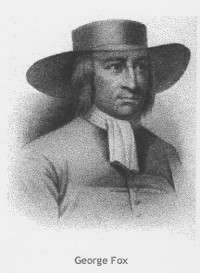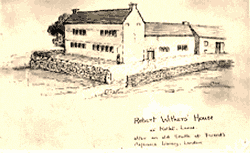OVER KELLET - A BRIEF HISTORY
Earlier it was mentioned that Over Kellet had no 'great personage'.� It did sire one remarkable man - Robert Widder, or Withers (1618 - 1686).� He became involved in the Quaker movement at it's inception in this area in 1652.� He invited George Fox to address a meeting at Kellet that year and with Thomas Leaper of Capernwray, he became one of the 'Valiant Sixty'.
 He followed Fox on his travels through England, Scotland and also America for two years, in the early days of the Colonies.� In addition to the expected privations of travel then, Withers endured physical attacks at meetings, once being left for dead; he was fined for refusing to take the Oath; he had goods and livestock distrained for refusing to attend church or pay tithes, or for holding illegal prayer meetings at his house (probably Brookside).� Whilst travelling with Fox, presumably his brother, and� then, son, farmed his land.
He followed Fox on his travels through England, Scotland and also America for two years, in the early days of the Colonies.� In addition to the expected privations of travel then, Withers endured physical attacks at meetings, once being left for dead; he was fined for refusing to take the Oath; he had goods and livestock distrained for refusing to attend church or pay tithes, or for holding illegal prayer meetings at his house (probably Brookside).� Whilst travelling with Fox, presumably his brother, and� then, son, farmed his land.
 He left part of his land to the Lancaster Friends.� His son's memory is perpetuated through the Withers' Trust.� His house was registered as a Meeting House two years after his death.� The name suggests that Friendly Cottage may also have been an (illegal) meeting house.� Oral tradition has it that the Quaker burial ground was in the small orchard opposite Greenbank Cottage, but this is not so.� No Quakers were buried here.
He left part of his land to the Lancaster Friends.� His son's memory is perpetuated through the Withers' Trust.� His house was registered as a Meeting House two years after his death.� The name suggests that Friendly Cottage may also have been an (illegal) meeting house.� Oral tradition has it that the Quaker burial ground was in the small orchard opposite Greenbank Cottage, but this is not so.� No Quakers were buried here.
 No more than 4 - 6 Quaker families were living in the parish in Withers' time, but 16 were fined for non attendance at church - this at a time when there were possibly about 60 households here.� The C17th was the high water mark of the movement here: it dwindled throughout the C18th.
No more than 4 - 6 Quaker families were living in the parish in Withers' time, but 16 were fined for non attendance at church - this at a time when there were possibly about 60 households here.� The C17th was the high water mark of the movement here: it dwindled throughout the C18th.
 The Parish today is a combination of retirement and commuter dwellers; those employed in the Parish are relatively few in number.� This of course was not always so.
The Parish today is a combination of retirement and commuter dwellers; those employed in the Parish are relatively few in number.� This of course was not always so.
Before the coming of the canal and rail, the Parish was isolated and virtually self sufficient.� We are used to seeing most of the land down to pasture.��As early as the C13th, the land was roughly in equal parts arable, grass, woodland and heath moor.� 150 years ago in Kellet village alone, some 300 acres were down to cereals and beans.� Instead of mature woods as we know them, there was much coppicing to meet the needs for charcoal burning, fencing, domestic use, tanning etc.� Quarrying of limestone, which had been very localised and small scale previously, became a major industry after the completion of the canal to Tewitfield in 1792.
 This new industry helped to alleviate the distress that resulted from the Enclosure of common land in 1805.� Some smallholders who could not make a living solely from from farming switched to quarry work.� Others had to leave the area.� The end of the Napoleonic Wars in 1815 saw the beginnings of a long decline in agriculture which was to persist until the 1939 -1945 war.� Land prices that had peaked during the Napoleonic Wars were not matched until the 1950's.
This new industry helped to alleviate the distress that resulted from the Enclosure of common land in 1805.� Some smallholders who could not make a living solely from from farming switched to quarry work.� Others had to leave the area.� The end of the Napoleonic Wars in 1815 saw the beginnings of a long decline in agriculture which was to persist until the 1939 -1945 war.� Land prices that had peaked during the Napoleonic Wars were not matched until the 1950's.